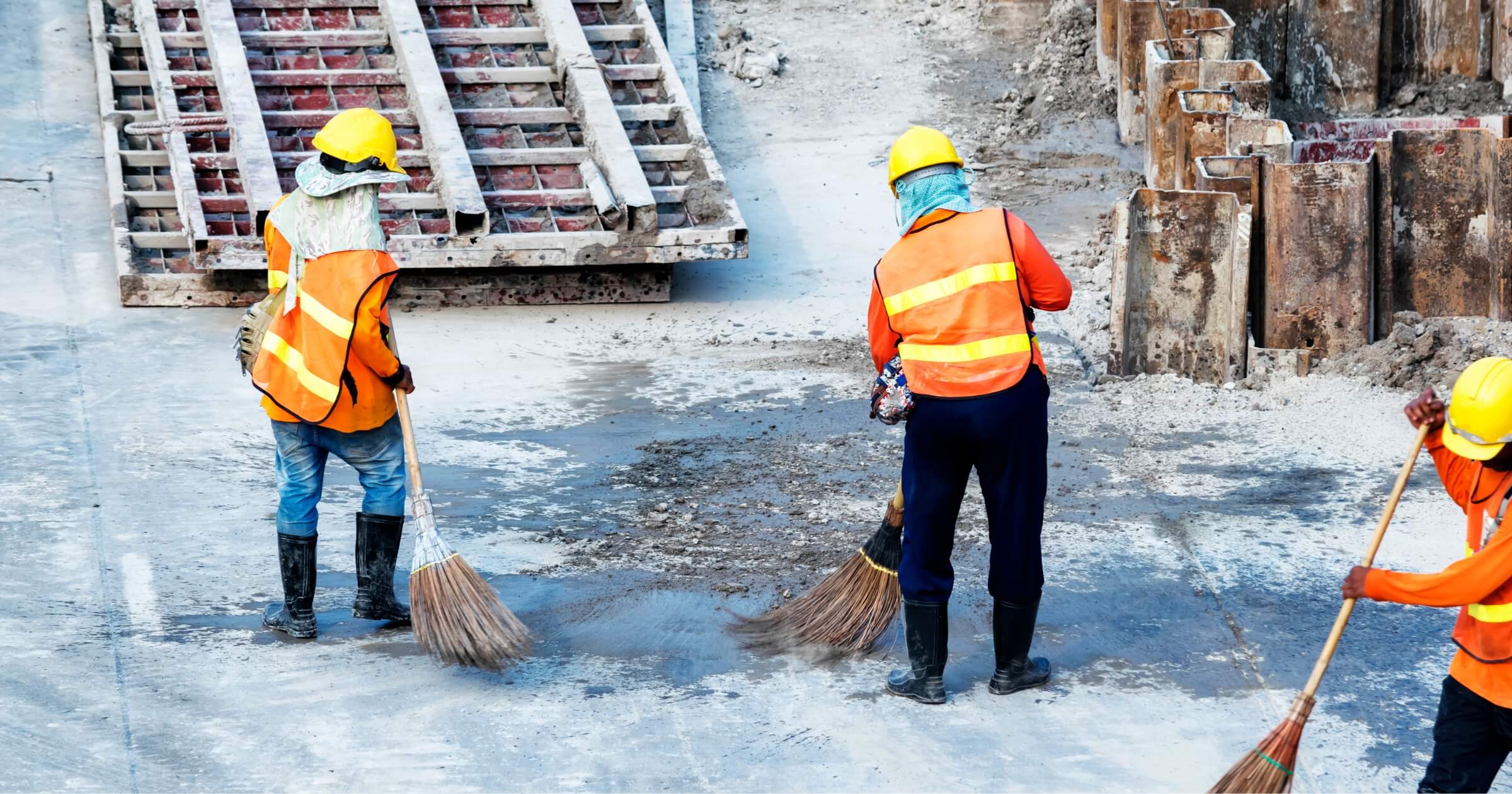Extreme weather can throw a major wrench into construction projects, causing delays, property damage, and safety risks. From hurricanes and heavy snow to flooding and extreme heat, construction sites face unique challenges during severe weather events. Preparing your construction site for extreme weather ahead of time can minimize damage, protect your crew, and reduce costly downtime.
Quick look
- Identify the most likely weather hazards in your region and create an emergency plan.
- Reinforce structures and secure loose materials to minimize damage during high winds or heavy snow.
- Equip your crew with appropriate PPE and ensure they’re trained for extreme weather conditions.
- Set up reliable weather monitoring systems and clear communication channels to stay ahead of incoming storms.
- Perform regular site inspections and emergency drills to keep everyone prepared.
What is considered extreme weather in construction?
Extreme weather refers to severe or unexpected weather conditions that can cause significant damage to infrastructure, property, and human life. For construction sites, this can include anything from hurricanes and blizzards to floods, heatwaves, and high winds. Each type of extreme weather poses unique challenges, making it critical for construction crews to be prepared for any situation.
How extreme weather can affect construction sites:
- High winds can topple scaffolding, equipment, and temporary structures.
- Flooding can erode foundations, damage materials, and halt work.
- Heavy snow adds excessive weight to structures and creates slip hazards.
- Extreme heat puts workers at risk of heat exhaustion and dehydration.
- Thunderstorms can cause electrical hazards, equipment failure, and injury from lightning strikes.
When construction sites aren’t prepared for extreme weather, it can lead to costly project delays, material damage, and increased safety risks. Having a strong plan in place for all of these situations will reduce the impact of extreme weather and keep your project moving forward. To make an effective plan for extreme weather, you need to start with a risk assessment.
4 steps to prepare your construction site for extreme weather

1. Assess risks and develop emergency plans
Identify potential weather hazards specific to your region
The first step in protecting your construction site from extreme weather is identifying the most likely hazards in your region. In coastal areas, hurricanes and flooding may be the biggest threats, while northern regions may need to prepare for heavy snow and freezing temperatures. Understanding the risks your site faces allows you to plan ahead even in freezing temperatures and minimize damage.
Look at historical weather data, talk to local experts, and consider seasonal weather patterns. Knowing what you’re up against makes it easier to implement protective measures.
Evaluate site vulnerabilities to these hazards
Once you know what type of extreme weather to expect, assess your site’s vulnerabilities. Are there materials that could easily be displaced by high winds? Is the site prone to flooding after heavy rain? Are there tall structures or scaffolding that could be unstable in extreme conditions?
Walk the site with your project manager and safety team to identify any potential weak spots. Pay attention to exposed materials, low-lying areas prone to water pooling, and any structures not yet fully secured.
Create a comprehensive employee emergency response plan
An emergency response plan based on the assessment of your hazards will protect workers and minimize damage during extreme weather. This plan should clearly outline communication protocols, safety procedures, and assigned roles for each team member. Everyone should know who to contact in an emergency and what steps to take if weather conditions worsen.
You also need to designate a site safety officer responsible for monitoring weather conditions and making decisions about work stoppage or evacuation. They will lead the way in establishing a clear line of communication, whether through radios, cell phones, or a designated emergency app. Also, make sure your team has access to emergency supplies such as first aid kits, flashlights, and water.
2. Secure and protect site infrastructure
Reinforce structures to withstand high winds and heavy snow loads
Unfinished structures are highly vulnerable to wind and snow damage, making reinforcement essential. For high-wind areas, use bracing and anchoring systems to keep structures stable. In areas prone to heavy snow, ensure that roofs and support beams can handle the extra weight.
Temporary structures like scaffolding and portable offices should also be reinforced. Double-check that beams, trusses, and unfinished walls are properly supported. Doing so can reduce costly setbacks and prevent dangerous collapses.
Properly store and anchor materials and equipment to prevent displacement
Loose materials and equipment are among the first things to cause damage in extreme weather. High winds can send plywood, tools, and equipment flying, creating a major hazard. Always anchor down materials or store them in secure, covered areas when extreme weather is approaching.
For equipment like cranes and scaffolding, use tie-downs or secure them to a fixed structure. Move lighter materials like insulation, drywall, and lumber that are not installed indoors or under tarps. The goal is to eliminate anything that could become a projectile during a storm.
Implement effective drainage systems to mitigate flooding risks
Flooding can quickly derail a construction project, causing water damage to foundations, materials, and electrical systems. Installing effective drainage systems can prevent costly water damage and keep your site operational.
Consider using pumps, trenches, or storm drains to redirect water away from work areas. Another strategy is to elevate materials that could be damaged by standing water. Keeping water away from critical work areas will prevent extensive damage.
3. Equip and train personnel
Provide appropriate personal protective equipment (PPE)
Workers need the right PPE in construction zones to stay safe during extreme weather. In freezing conditions, insulated gloves, thermal clothing, and slip-resistant boots help keep workers warm. In extreme heat, light clothing, hydration packs, and cooling towels can help prevent heat exhaustion. The PPE is all dependent on the weather your site is likely to experience.
Regardless, your crew should always have access to weather-appropriate PPE. Make sure you have backup supplies on hand in case weather conditions change rapidly. Keeping workers comfortable and safe keeps productivity levels high, even during tough weather.
Conduct regular training sessions on emergency procedures and equipment use
Regular training keeps your team prepared for emergency situations. Schedule quarterly training sessions covering weather-specific scenarios such as high winds, heavy snow, or flooding. Demonstrate how to safely use emergency equipment like generators, pumps, and evacuation systems.
Training should also include response protocols, evacuation routes, and how to contact emergency personnel. Keeping your crew informed and confident helps everyone stay on the same page when unexpected weather hits.
Perform drills simulating extreme weather scenarios to ensure preparedness
Conducting drills for extreme weather events can save lives in a real emergency as it trains work personnel to respond appropriately. These don’t have to be frequent but should be scheduled periodically to simulate situations like high winds, heavy snow, or flooding. These drills should include evacuation, securing materials, and communication procedures. After each drill, gather feedback from your crew to identify areas for improvement.
4. Monitor weather and maintain communication
Utilize reliable weather monitoring systems for real-time updates
Investing in a reliable weather monitoring system can provide your site with real-time updates. Weather apps, radar systems, and professional weather alerts can help you make informed decisions about work stoppages or evacuations. Staying informed allows you to take action before extreme weather hits, and checking forecasts throughout the day can help you spot sudden weather shifts and respond quickly.
Establish clear communication channels to inform all personnel of impending weather events
Clear communication is critical when severe weather approaches. Make sure all team members have access to reliable communication channels like two-way radios, text alerts, or site-wide announcements. Hold safety briefings to discuss weather forecasts and any potential site shutdowns if your site is prone to extreme weather events.
Maintain updated contact lists for swift coordination during emergencies
Having up-to-date contact lists for all crew members, subcontractors, and emergency services will make sure that everyone gets the memo during an expected extreme weather event. Post these contact lists in a central, visible location like the site office and make sure key team members have backup copies in case of power outages. Having a reliable and up-to-date list minimizes the chance of someone getting hurt during emergencies.
Bottom line
Extreme weather poses real risks to construction sites, but proper preparation can significantly reduce damage and downtime. By identifying potential hazards, reinforcing structures, securing materials, and ensuring clear communication, your crew can stay safe and keep the project moving forward.
Want to stay updated on the latest construction safety tips? Subscribe to our newsletter at https://underthehardhat.org/join-us/ to get updates delivered straight to your inbox!


